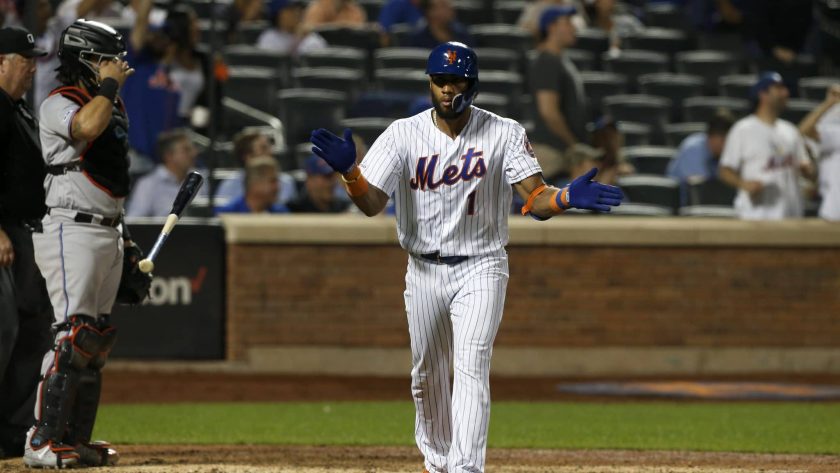New York Mets SS Amed Rosario needs to improve against offspeed pitches in 2020

While Amed Rosario is trending towards an impressive 2020, adjusting against offspeed pitches could help him unlock his full potential.
[sc name=”thomas-hall-banner” ]Heading into this spring, the New York Mets were hopeful that Amed Rosario would be able to take that next step in his development and become more polished during his third full major-league season.
But with spring training canceled and the start of the regular season now pushed back, Rosario’s chances of accomplishing that feat have undoubtedly declined. Nevertheless, the 24-year-old is still trending towards a successful season at the plate and he’ll likely be able to at least replicate his results from last year.
During the 2019 campaign, the 6-foot-2 shortstop produced career-highs in home runs (15), RBIs (72), BABIP (.338), wOBA (.318), average (.287), on-base percentage (.323), slugging percentage (.432), OPS (.755), and wRC+ (100). His fWAR rating (2.7) was additionally the highest it’s ever been in the majors.
In addition, Rosario generated career-lows with his ground ball rate (48.3%), pull rate (30.4%), and soft contact rate (14.5%). As a result, the right-handed batter was able to increase his line drive rate by 1.5%, his hard-hit rate by 5.7%, and his opposite-field rate by 2.2% from 2018.
The Mets would likely be pleased with a similar performance from Rosario in 2020. Nonetheless, he carries the potential to grow even further and could reach that level by making an adjustment at the plate this season.
Despite his encouraging results from the 2019 campaign, the Dominican native failed to increase his walk rate (4.9% to 4.7%) and fly ball rate (29.6% 29.3%) from 2018. His hard-hit rate could’ve also been higher in 2019. Furthermore, these disappointing metrics were largely caused by his woes against offspeed pitches.
Since Rosario debuted in 2017, he’s failed to be successful against changeups and splitters, making him susceptible to pitchers who rely on those types of pitches. While he made some progress against them in 2019, the righty still has a lot of work to do before he can move forward.
Last season, the former top prospect within the Mets system recorded a .242 average, .254 xAVG, .306 slugging percentage, .300 xSLG, .242 wOBA, .247 xwOBA, 33.8% whiff rate, and 23.8% strikeout rate against offspeed pitches.
Along with these troubling results, Rosario’s issues to create fly balls and hard contact against changeups and splitters worsened in 2019. If these struggles continue, he’ll likely face even more offspeed pitches this season.
After producing a measly 18.6% fly ball rate and 20.9% hard-hit rate against offspeed pitches in 2018, Rosario saw those numbers decline even further last season. In total, he created a miserable 10.6% fly ball rate and 19.1% hard-hit rate. His groundball rate additionally increased by 9% during the 2019 campaign.
For Rosario, his woes against offspeed pitches from last season were likely caused by his concerningly low launch angle against them. After he corrected his swing path against changeups and splitters during his first full season in the majors, the young shortstop suddenly reverted back to his bad habits in 2019.
During the 2017 campaign, No. 1 recorded an average launch angle of just three degrees against offspeed pitches. But in 2018, he increased that specific average launch angle to 15 degrees. He then saw that number drop back down to a measly seven degrees last season.
As a result of Rosario’s terrible launch angle, he failed to hit any offspeed pitches with his barrel and recorded an awful 83.9 mile-per-hour average exit velocity against them in 2019. The only positive aspect in regards to his launch angle from last season was that it allowed him to increase his line drive rate by 8.9%.
Along with struggling to create fly balls and hard contact against offspeed pitches, Rosario hasn’t generated a single walk against changeups or splitters in the major leagues. In addition, he’s not making enough contact when he chases those pitches out of the strike zone.
Of the 244 offspeed pitches thrown to Rosario in 2019, 61.5% of them were located outside the strike zone. While he only chased 37.3% of those pitches, he recorded a 55.4% whiff rate against them.
Based on these metrics, the Mets shortstop will likely see fewer fastballs and more offspeed pitches this season if he doesn’t improve his approach at the plate. In order to be successful against changeups and splitters, he’ll need to become more disciplined and increase his launch angle.
If Rosario starts laying off offspeed pitches that are located below his knees, he’ll likely continue lowering his strikeout rate. His walk rate should also increase significantly. As for his launch angle against changeups and splitters, if he increases it back up to 15 degrees or higher, he should be able to produce higher fly ball and hard-hit rates this season.
Since Rosario will be eligible for arbitration for the first time next winter, it’ll be very important for him to make these adjustments when and if baseball resumes. If his struggles against offspeed pitches return in 2020, then it could be difficult for both sides to agree on his 2021 salary.
The Mets are hoping to surge back into the postseason for the first time since 2016, so they’ll need their offense to provide consistent run support for their pitching staff. If Rosario can increase his production level, he’ll be able to help put his team in a better position to make the playoffs in 2020.
Note: All stats are from FanGraphs and Baseball Savant.






